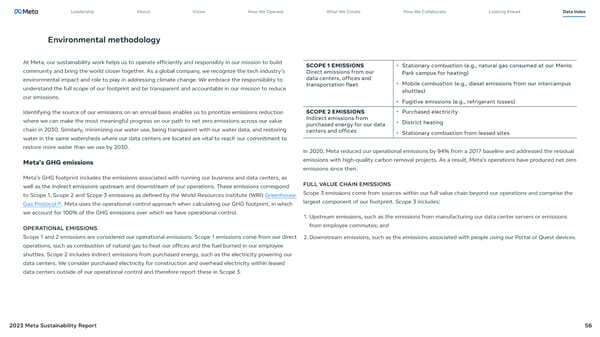Leadership About Vision How We Operate What We Create How We Collaborate Looking Ahead Data Index Environmental methodology At Meta, our sustainability work helps us to operate efficiently and responsibly in our mission to build SCOPE 1 EMISSIONS • Stationary combustion (e.g., natural gas consumed at our Menlo community and bring the world closer together. As a global company, we recognize the tech industry’s Direct emissions from our Park campus for heating) environmental impact and role to play in addressing climate change. We embrace the responsibility to data centers, offices and understand the full scope of our footprint and be transparent and accountable in our mission to reduce transportation fleet • Mobile combustion (e.g., diesel emissions from our intercampus shuttles) our emissions. • Fugitive emissions (e.g., refrigerant losses) Identifying the source of our emissions on an annual basis enables us to prioritize emissions reduction SCOPE 2 EMISSIONS • Purchased electricity where we can make the most meaningful progress on our path to net zero emissions across our value Indirect emissions from • District heating purchased energy for our data chain in 2030. Similarly, minimizing our water use, being transparent with our water data, and restoring centers and offices • Stationary combustion from leased sites water in the same watersheds where our data centers are located are vital to reach our commitment to restore more water than we use by 2030. In 2020, Meta reduced our operational emissions by 94% from a 2017 baseline and addressed the residual Meta’s GHG emissions emissions with high-quality carbon removal projects. As a result, Meta’s operations have produced net zero emissions since then. Meta’s GHG footprint includes the emissions associated with running our business and data centers, as FULL VALUE CHAIN EMISSIONS well as the indirect emissions upstream and downstream of our operations. These emissions correspond to Scope 1, Scope 2 and Scope 3 emissions as defined by the World Resources Institute (WRI) Greenhouse Scope 3 emissions come from sources within our full value chain beyond our operations and comprise the Gas Protocol↗. Meta uses the operational control approach when calculating our GHG footprint, in which largest component of our footprint. Scope 3 includes: we account for 100% of the GHG emissions over which we have operational control. 1. Upstream emissions, such as the emissions from manufacturing our data center servers or emissions OPERATIONAL EMISSIONS from employee commutes; and Scope 1 and 2 emissions are considered our operational emissions. Scope 1 emissions come from our direct 2. Downstream emissions, such as the emissions associated with people using our Portal or Quest devices. operations, such as combustion of natural gas to heat our offices and the fuel burned in our employee shuttles. Scope 2 includes indirect emissions from purchased energy, such as the electricity powering our data centers. We consider purchased electricity for construction and overhead electricity within leased data centers outside of our operational control and therefore report these in Scope 3. 2023 Meta Sustainability Report 56
 Meta 2023 Sustainability Report Page 55 Page 57
Meta 2023 Sustainability Report Page 55 Page 57